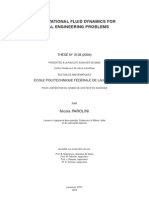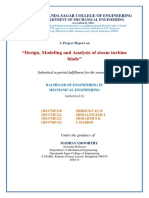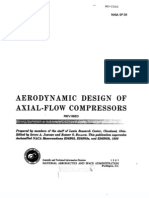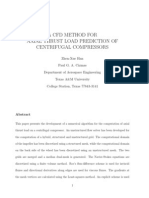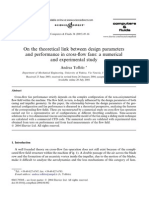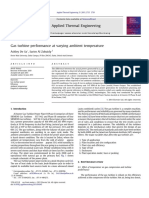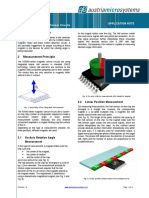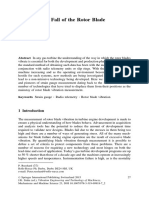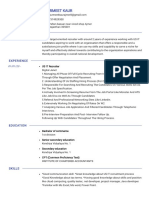Analysis of Axial Flow Fan Using Ansys
Analysis of Axial Flow Fan Using Ansys
Uploaded by
garystevensozCopyright:
Available Formats
Analysis of Axial Flow Fan Using Ansys
Analysis of Axial Flow Fan Using Ansys
Uploaded by
garystevensozOriginal Description:
Original Title
Copyright
Available Formats
Share this document
Did you find this document useful?
Is this content inappropriate?
Copyright:
Available Formats
Analysis of Axial Flow Fan Using Ansys
Analysis of Axial Flow Fan Using Ansys
Uploaded by
garystevensozCopyright:
Available Formats
International Journal of Advanced Engineering Technology
E-ISSN 0976-3945
Research Article
ANALYSIS OF BLADES OF AXIAL FLOW FAN USING ANSYS.
Mahajan Vandana N.,* Shekhawat Sanjay P.
Address for Correspondence
Department of Mechanical Engg. S.S.B.Ts College of Engg. and Technology, Bambhori, Jalgaon E Mail er.vandana@rediffmail.com ABSTRACT:
In the present paper CFD based investigation has been reported in order to study the effect of change in speed of fan on velocity, pressure, and mass flow rate of axial flow fan. It has been observed that there is a significant change in mass flow rate, velocity of rotor and guide or stator vanes as the speed of fan is varied. As the performance of fan is directly dependent on mass flow output. So there should be a moderate velocity and pressure profile as all these parameters are co-related. In order to predict the mass flow output, velocity and pressure on stator and rotor section ,analysis is done using a software ansys12.and to create a general idea about an axial flow fan a model is created using a modeling software catiav5. KEY WORDS: Stator vanes, runner, pressure gain, CFD, mass flow rate, CATIA V5.
INTRODUCTION The axial-flow fan has blades that force air to move parallel to the shaft about which the blades rotate. In an axial-flow fan, with the runner and guide vanes in a cylindrical housing, air passes through the runner essentially without changing its distance from the axis of rotation. There is no centrifugal effect. Guide, or stator, vanes serve to smooth the airflow and improve efficiency. In general, an axial-flow fan is suitable for a relatively large rate of flow with a relatively small pressure gain, and a centrifugal fan for a small rate of flow and a large pressure gain. Actually, the pressure developed in a fan is small compared with the pressure developed in a compressor. Airflow across the plane of the fan is not uniform varying from positive at the tip to negative at the center of the fan. Blade shape and twist of the airfoil along the blade affects the shape of the velocity profile. Velocity profile of a welldesigned tapered blade with a generous twist compared to a constant chord blade with minimal twist. Work performed by a fan blade is basically a function of three factors at any point or radius: Chord width, Airfoil twist, Tangential velocity squared. Hence the shape of blades varies the efficiency and performance of fan. The flow of fluid in axial flow fans is parallel to the axis of fan. So the pressure, temperature, and velocity of fluid must be moderate. Blades should withstand to the conditions .so shape of fan blades is optimized using software. The rapid advance made in computer hardware and software led to significant developments in FEA software. FE programming gas emerged as a specialized discipline
which requires knowledge and experience in the diverse areas such as FE technology including foundations of machines, and numerical analysis on the one hand and the computational skills in areas of software technology including programming techniques, data structure, data base management and computer graphics on the other hand. AIM 1. Modeling of blades of axial flow fan. 2. Analysis of mass flow of fluid through blades by considering various angular velocities using Ansys. 3. Analysis of velocity on periodic surface by considering various angular velocities using Ansys. 4. Analysis of rotor pressure considering various angular velocities using Ansys. 5. Analysis of stator pressure considering various angular velocities using Ansys. 6. Analysis of mid surface velocity by considering various angular velocities using Ansys. The flow of fluid in axial flow fans is parallel to the axis of fan. So the pressure, temperature, and velocity of fluid must be moderate. Blades should withstand to the conditions. In this case speed of fan is varied at 1000r.p.m. 1800 r.p.m. 2500 r.p.m. and then corresponding changes in pressure and velocity at blades section is analyzed using a Ansys software. Also modeling of the fan is done using modeling software CATIA V5. In CATIA V5 various commands are used such as pad, shaft, plane, circular pattern etc.
IJAET/Vol.II/ Issue II/April-June, 2011/261-270
International Journal of Advanced Engineering Technology
E-ISSN 0976-3945
EXPERIMENTAL WORK Three-dimensional air flow through an axial, multistage fan will be solved in this analysis. There are two sections of flow created by this multistage fan. In the first stage, flow is created by a 9 bladed rotor, which rotates at 1800 rpm. In the second stage, the flow is "straightened out" by means of a 12 bladed stator section located just downstream of the rotor section, as shown in Fig.1.
Fig.03 Rotor (inclined to the plane of rotation) and stator (parallel to the axis of rotation) Analysis of rotor and stator blades using Ansys 12: Three dimensional air flow analysis through an axial, multistage fan using mixing plane model
Fig 01 blade section At the inlet to the rotor, air at 0 Pa (gauge) is drawn in. At the outlet, air is exhausted at 0 Pa In this investigation, k- model with standard wall treatment is used in FLUENT .Air is taken the fluid flowing through stator and rotor section .mixing plane model is model is used.CFD-POST is used to calculate velocity and pressure at rotor and stator section at 1000 r.p.m. 1800 r.p.m. and 2500 r.p.m. In CFD-POST, fluid is considered as moving from rotor to stator while stator and rotor is kept stationary. RESULTS PART MODELING USING CATIA V5:
Fig.04 The shape of the blade describes the geometry as shown above.
Fig.05a) Boundary conditions Fig.02 stator and rotor
IJAET/Vol.II/ Issue II/April-June, 2011/261-270
International Journal of Advanced Engineering Technology
E-ISSN 0976-3945
Fig 5 b) Boundary conditions Initial boundary conditions are as flows: Flow is created by a 9 bladed rotor, which rotates at 1800 rpm. In the second stage, the flow is "straightened out" by means of a 12 bladed stator section located just downstream of the rotor section.
Fig.06 complete mesh Blade is divided into smaller areas/volumes for use in numerical solution methods.
Fig 07 Mass flow rate output at 1000 r.p.m.
IJAET/Vol.II/ Issue II/April-June, 2011/261-270
International Journal of Advanced Engineering Technology
E-ISSN 0976-3945
Fig.08 Mass flow output at 1800 r.p.m.
Fig.09 Mass flow output at 2500
IJAET/Vol.II/ Issue II/April-June, 2011/261-270
International Journal of Advanced Engineering Technology
E-ISSN 0976-3945
Fig 10 Rotor velocity at 1000 r.p.m.
Fig. 11 Rotor velocity at 1800 r.p.m.
IJAET/Vol.II/ Issue II/April-June, 2011/261-270
International Journal of Advanced Engineering Technology
E-ISSN 0976-3945
Fig.12 Rotor velocity at 2500 r.p.m.
Fig. 13 Rotor pressure at 1000 r.p.m.
IJAET/Vol.II/ Issue II/April-June, 2011/261-270
International Journal of Advanced Engineering Technology
E-ISSN 0976-3945
Fig.14 Rotor pressure at 1800 r.p.m.
Fig.15 Rotor pressure at 2500 r.p.m.
IJAET/Vol.II/ Issue II/April-June, 2011/261-270
International Journal of Advanced Engineering Technology
E-ISSN 0976-3945
Fig.16 Graph of RPM v/s Mass Flow From the graph it is found that, Mass flow rate of fluid is directly proportional to speed of rotor. As the rotor speed increases the stator outlet mass flow rate increases.
Fig.17 Graph of p v/s Mass Flow From the graph it is found that, Mass flow rate of fluid is directly proportional to pressure drop between fluid particles. As the mass flow rate increases the pressure drop increases.
IJAET/Vol.II/ Issue II/April-June, 2011/261-270
International Journal of Advanced Engineering Technology
E-ISSN 0976-3945
DISCUSSION We are taken three different iteraction at different rpm as follows 1000rpm, 1800rpm & 2500rpm. We get the following result for it. Mass Flow at outlet Rate (Kg/s) For 1000 rpm =0.01Kg/s For 1800 rpm =0.018Kg/s For 2500 rpm = 0.20kg/s As the rpm of the rotor increase the mass flow at outlet get increase the increment in output is not linear. Table 1.Rotor Velocity Plot (M/s)
Rotor Velocity Plot (M/s) For diff R.P.M. Minimum O/P value For 1000 rpm 1.46m/s For 1800 rpm 1..31m/s For 2500 rpm 1.82m/s Rotor Pressure Plot (Pascal) For diff R.P.M. Minimum O/P value For 1000 rpm 0.146pascal For 1800 rpm 0.38pascal For 2500 rpm 0.72pascals Maximum O/P 14.6m/s 26.3m/s 36.5m/s Maximum O/P 150pascal 500pascal 937pascal
10. Research paper on Computational Fluid Dynamics (CFD) Modeling, Christopher Riff.
As the rpm of rotor is increase the pressure on stator blade gate increase at very high rate. This result is obtained from the analysis using ANSYS for the different rpm. For further optimization one can change the angle of blade (in the range of 20 to 30) One can also change the shape of the blade for the gating higher output of the air flow REFERENCES
1. 2. 3. A report on fan design by Moore, 800 s. Missouri avenue Marceline, Missouri. A report on axial flow fan and centrifugal fan by marathon electrelectrical, a regal Beloit company. A research report on blades for axial flow fan by Camargo Do, Amaranth Odilon Antonio (Rua Fernandes de Barros, 1455 apto. 07 -200 Curitiba, PR, CEP-80040, BR). A research report on basic guidelines for plastic conversion of metal axial flow fans by BASF CORPORATION. A Report on Basic Fan Laws - Axial Fan Blades by Air Turbine Propeller Company Energy Efficient Axial Flow FRP Fans by TIFAC, Department of science and technology, govt. of India. CFD solutions for turbo machinery design. CAD/CAM & Automation, Technical Prakashan Pune, 2003, (pp 4.143-4.144) by R.B. Patil and A.M. Chakradeo (2003) Mechanical Engineering Designs Second Edition McGraw-Hill Book Company, 1987, Joseph Edward Shingle.
4.
5. 6.
7. 8.
9.
IJAET/Vol.II/ Issue II/April-June, 2011/261-270
You might also like
- Industrial Training Report For Computer Science PDFDocument3 pagesIndustrial Training Report For Computer Science PDFAdira Hayat100% (2)
- DM-Intro 16.0 L05 Geometry Simplification and RepairDocument24 pagesDM-Intro 16.0 L05 Geometry Simplification and RepairNitin B maskeNo ratings yet
- CFX TBR Aeromechanics 18.0 WS01 TT-AxialTurbineDocument53 pagesCFX TBR Aeromechanics 18.0 WS01 TT-AxialTurbineAnubhav Sharma100% (2)
- Chapter 3 Module 4 Lesson 1 Implementing The Designed Curriculum As A Change ProcessDocument83 pagesChapter 3 Module 4 Lesson 1 Implementing The Designed Curriculum As A Change ProcessApril mae heyres100% (1)
- Unbalanced Forces and Couples: Balanced Opposed DesignDocument2 pagesUnbalanced Forces and Couples: Balanced Opposed DesignJose Luis RattiaNo ratings yet
- Computational Fluid Dynamics For Naval Engineering ProblemsDocument184 pagesComputational Fluid Dynamics For Naval Engineering ProblemsandevariNo ratings yet
- Aerodynamic and Mechanical Design of An 8 - 1 Pressure Ratio Centrifugal CompressorDocument147 pagesAerodynamic and Mechanical Design of An 8 - 1 Pressure Ratio Centrifugal CompressorvincemugnaioNo ratings yet
- MSI Centrifugal Impeller Structural Resonance PDFDocument9 pagesMSI Centrifugal Impeller Structural Resonance PDFJigneshNo ratings yet
- Introduction To Computational Fluid Dynamics Lecture 2: CFD IntroductionDocument18 pagesIntroduction To Computational Fluid Dynamics Lecture 2: CFD IntroductionHunter NoVaNo ratings yet
- APD Dynamic StressesDocument11 pagesAPD Dynamic StressesadehriyaNo ratings yet
- Axial Fan NotchDocument3 pagesAxial Fan NotchhahasiriusNo ratings yet
- "Design, Modeling and Analysis of Steam Turbine Blade": Dayananda Sagar College of EngineeringDocument66 pages"Design, Modeling and Analysis of Steam Turbine Blade": Dayananda Sagar College of EngineeringSHREENIVAS MNo ratings yet
- NASA SP36 ExtractoDocument82 pagesNASA SP36 ExtractoDiego Guerrero VelozNo ratings yet
- ME2352-DTS Question BankDocument8 pagesME2352-DTS Question BankNaresh015No ratings yet
- Axial Thrust Load Prediciton of Centrifugal CompressorsDocument44 pagesAxial Thrust Load Prediciton of Centrifugal CompressorsTaylor100% (1)
- AWS100 Ch04 StaticDocument56 pagesAWS100 Ch04 StaticLalNo ratings yet
- Design and Analysis of Centrifugal Pump Impeller Using CFD Analysis IJERTCONV5IS07017Document6 pagesDesign and Analysis of Centrifugal Pump Impeller Using CFD Analysis IJERTCONV5IS07017VSNo ratings yet
- CFD Study of A Wind Turbine RotorDocument83 pagesCFD Study of A Wind Turbine Rotorfederico_malatesta100% (5)
- Me 2352 Design of Transmission Systems: III Year MechanicalDocument14 pagesMe 2352 Design of Transmission Systems: III Year MechanicalAravinthan VijayanNo ratings yet
- Tema 6 - HP Axial Flow TurbineDocument104 pagesTema 6 - HP Axial Flow Turbinefdsfsdfdsfsf100% (1)
- Influence of The Number of Blades of Miniature Centrifugal Impeller On Compressor PerformanceDocument6 pagesInfluence of The Number of Blades of Miniature Centrifugal Impeller On Compressor PerformanceSuherman MuktiNo ratings yet
- Fluent-Fsi 14.0 ws3 Hyperelastic Flap Part1Document22 pagesFluent-Fsi 14.0 ws3 Hyperelastic Flap Part1Raúl Sánchez100% (1)
- CFX Multiphase 14.5 WS01 Rectangular Bubble ColumnDocument37 pagesCFX Multiphase 14.5 WS01 Rectangular Bubble Columnnga911No ratings yet
- Analysis of FlywheelDocument17 pagesAnalysis of FlywheelShubham SharmaNo ratings yet
- Ref Prop 8Document57 pagesRef Prop 8NannanZhao100% (5)
- Fluids EngineeringDocument29 pagesFluids EngineeringPankajYadavNo ratings yet
- Ejercicios 3DDocument6 pagesEjercicios 3DDaniel Joya BeltranNo ratings yet
- Spike Contour AlgorithmDocument10 pagesSpike Contour AlgorithmAleksa TrifkovićNo ratings yet
- CFX-Intro 14.5 L10 TurbulenceDocument46 pagesCFX-Intro 14.5 L10 TurbulenceShaheen S. Ratnani100% (1)
- Fluent-Intro 16.0 L03 BoundaryConditions PDFDocument51 pagesFluent-Intro 16.0 L03 BoundaryConditions PDFAnonymous 8209ZTNo ratings yet
- Setting Up Oscillatory Moving Boundaries in Fluent Using UDFs PDFDocument18 pagesSetting Up Oscillatory Moving Boundaries in Fluent Using UDFs PDFmustafa10ramziNo ratings yet
- Mec658 Chapter 1Document25 pagesMec658 Chapter 1Hafizudin DaudNo ratings yet
- FLUENT Tutorial 5 - BlowerDocument26 pagesFLUENT Tutorial 5 - BlowerKwanchai ChoicharoenNo ratings yet
- Bearing Dynamic Coefficients of Flexible Pad Journal Bearings LinkedDocument8 pagesBearing Dynamic Coefficients of Flexible Pad Journal Bearings LinkedBa1313yNo ratings yet
- Castegnaro Stefano TesiDocument166 pagesCastegnaro Stefano Tesiphael_garridoNo ratings yet
- On The Theoretical Link Between Design Parameters and Performance in Cross Flow Fans A Numerical and Experimental Study 2005 Computers and FluidsDocument18 pagesOn The Theoretical Link Between Design Parameters and Performance in Cross Flow Fans A Numerical and Experimental Study 2005 Computers and Fluidsankushanks2591No ratings yet
- Desa2011 PDFDocument5 pagesDesa2011 PDFTayyabIsmailNo ratings yet
- Turbulence Modeling - by Tomer AvrahamDocument93 pagesTurbulence Modeling - by Tomer AvrahamRaúl CastellónNo ratings yet
- Radial Equilibrium Theory PDFDocument26 pagesRadial Equilibrium Theory PDFLuis C. Sosa ManzoNo ratings yet
- Vehicle Dynamics: Vehicle Acceleration - Effect of Load TransferDocument10 pagesVehicle Dynamics: Vehicle Acceleration - Effect of Load Transferbudi waluyoNo ratings yet
- Couplings PDFDocument34 pagesCouplings PDFAhmed El-Shafei100% (1)
- Hfss 2way Thermal DimensionsDocument34 pagesHfss 2way Thermal DimensionscutefrenzyNo ratings yet
- Aeroelasticity of Turbomachines: MUSAF II Colloquium, Toulouse, FranceDocument33 pagesAeroelasticity of Turbomachines: MUSAF II Colloquium, Toulouse, FrancejamesNo ratings yet
- Schulung CERN 2014 MayDocument1,085 pagesSchulung CERN 2014 Maydanaosajo100% (3)
- Energy: Marco Astol Fi, Matteo C. Romano, Paola Bombarda, Ennio MacchiDocument12 pagesEnergy: Marco Astol Fi, Matteo C. Romano, Paola Bombarda, Ennio MacchiJosé Fco. VillegasNo ratings yet
- Create and Customize Your Physical ModelsDocument30 pagesCreate and Customize Your Physical Modelsraul19rsNo ratings yet
- Punthesis PDFDocument197 pagesPunthesis PDFkhumkbaj8346No ratings yet
- Torsional Vibration of Turbomachinery - Duncan N. Walker PDFDocument136 pagesTorsional Vibration of Turbomachinery - Duncan N. Walker PDFkolle_sdestefa100% (1)
- Intership 2 PPT FinalDocument25 pagesIntership 2 PPT FinalRajdeep MallickNo ratings yet
- CFD Lab Manual PK Final PDFDocument55 pagesCFD Lab Manual PK Final PDFYBSV PRASADNo ratings yet
- Fluent 6.3 Udf Manual - 8.2Document9 pagesFluent 6.3 Udf Manual - 8.2Ramy RaafatNo ratings yet
- Rotor - Dynamics - v14 - Open Days Feb 2012 PDFDocument46 pagesRotor - Dynamics - v14 - Open Days Feb 2012 PDFAnder GogenolaNo ratings yet
- 01 Belt DriveDocument54 pages01 Belt DrivessNo ratings yet
- General Description: Magnet Selection Guide Application NoteDocument15 pagesGeneral Description: Magnet Selection Guide Application NotesekoNo ratings yet
- 2013-J C Han GT Heat Transfer ReviewDocument15 pages2013-J C Han GT Heat Transfer ReviewSsheshan PugazhendhiNo ratings yet
- Introductory Applications of Partial Differential Equations: With Emphasis on Wave Propagation and DiffusionFrom EverandIntroductory Applications of Partial Differential Equations: With Emphasis on Wave Propagation and DiffusionNo ratings yet
- Energy Harvesting Using Mechanical Vibrations A Complete GuideFrom EverandEnergy Harvesting Using Mechanical Vibrations A Complete GuideNo ratings yet
- Hands-On Simulation Modeling with Python,: Develop simulation models for improved efficiency and precision in the decision-making processFrom EverandHands-On Simulation Modeling with Python,: Develop simulation models for improved efficiency and precision in the decision-making processNo ratings yet
- Numerical Flow Analysis of An Axial Flow PumpDocument6 pagesNumerical Flow Analysis of An Axial Flow Pumpbinho58No ratings yet
- Fan Efficiency 2Document6 pagesFan Efficiency 2jgarciablancoNo ratings yet
- Acoustic Models: Numerical Solution TechniquesDocument8 pagesAcoustic Models: Numerical Solution TechniquesgarystevensozNo ratings yet
- The Rise and Fall of The Rotor Blade Strain GaugeDocument12 pagesThe Rise and Fall of The Rotor Blade Strain GaugegarystevensozNo ratings yet
- Nafems Benchmark AerospaceDocument57 pagesNafems Benchmark Aerospacegarystevensoz0% (1)
- Development and Implementation of A Flight Test Program For A Geometrically Scaled Joined Wing Sensorcraft Remotely Piloted VehicleDocument258 pagesDevelopment and Implementation of A Flight Test Program For A Geometrically Scaled Joined Wing Sensorcraft Remotely Piloted VehiclegarystevensozNo ratings yet
- The Missing Mechanical Circuit ElementDocument17 pagesThe Missing Mechanical Circuit ElementgarystevensozNo ratings yet
- Solving Laplace EquationDocument42 pagesSolving Laplace Equationgarystevensoz100% (1)
- Damping ModelsDocument23 pagesDamping ModelsgarystevensozNo ratings yet
- System Coupling Users GuideDocument144 pagesSystem Coupling Users GuidegarystevensozNo ratings yet
- Karman Treffitz TransformationDocument24 pagesKarman Treffitz Transformationgarystevensoz100% (1)
- Aerospace America Dec 2012Document116 pagesAerospace America Dec 2012garystevensozNo ratings yet
- Spacecraft Loads AnalysisDocument126 pagesSpacecraft Loads AnalysisSimone RagionieriNo ratings yet
- Naca Report 496 TheodorsenDocument21 pagesNaca Report 496 TheodorsengarystevensozNo ratings yet
- 777 Empennage Certification ApproachDocument18 pages777 Empennage Certification Approachgarystevensoz100% (2)
- Boundary Layer NotesDocument17 pagesBoundary Layer NotesgarystevensozNo ratings yet
- Confomral Mapping - WakeDocument9 pagesConfomral Mapping - WakegarystevensozNo ratings yet
- DukeMed Magazine - Spring 2012Document58 pagesDukeMed Magazine - Spring 2012Duke Department of MedicineNo ratings yet
- 9 Threshold OCEAN VUONG COMPLETE NOTESDocument4 pages9 Threshold OCEAN VUONG COMPLETE NOTEShibamariyam49No ratings yet
- Review of Materials Process - Summer 2023Document14 pagesReview of Materials Process - Summer 2023Celeste EdenloffNo ratings yet
- Grade - 1 Exercises MusicaMathsDocument34 pagesGrade - 1 Exercises MusicaMathsNarendraNo ratings yet
- Math 8 - Unit 6 - Pythagorean Theorem in This Unit, Prove and Apply The Pythagorean Theorem and Its ConverseDocument3 pagesMath 8 - Unit 6 - Pythagorean Theorem in This Unit, Prove and Apply The Pythagorean Theorem and Its ConverseJhoy CabigasNo ratings yet
- 23 Zero ConditionalDocument7 pages23 Zero ConditionalCristian González ChávezNo ratings yet
- Chemistry Notes Unit 4 2011 End-Year PDFDocument35 pagesChemistry Notes Unit 4 2011 End-Year PDFAnonymous na314kKjOANo ratings yet
- Soal Bahasa Inggris 11Document13 pagesSoal Bahasa Inggris 11maulanagaming077No ratings yet
- Huawei WLAN Product Documentation BookshelfDocument310 pagesHuawei WLAN Product Documentation BookshelfАида БегайдароваNo ratings yet
- Down SyndromeDocument74 pagesDown Syndromeanumeha sharma100% (5)
- Math5 Week1Document2 pagesMath5 Week1edzille mae tabamoNo ratings yet
- Shashi Prakash SIPDocument37 pagesShashi Prakash SIPrishabh tiwariNo ratings yet
- Lost in BostonDocument3 pagesLost in Bostonba1084No ratings yet
- Admission Form 2023-24Document2 pagesAdmission Form 2023-24freshfooddemandsNo ratings yet
- East Asian Economy and Society (Ecos) : Master of Arts (Ma)Document4 pagesEast Asian Economy and Society (Ecos) : Master of Arts (Ma)ElbekriNo ratings yet
- Past PapersDocument5 pagesPast PapersJustine MwendaNo ratings yet
- Dramatic Arts. Grade 12Document18 pagesDramatic Arts. Grade 12sevinspaceNo ratings yet
- Role Play and Seminar: Presented By: Nivedita Kochar 2040982204 M.Sc. Nursing 1 YearDocument27 pagesRole Play and Seminar: Presented By: Nivedita Kochar 2040982204 M.Sc. Nursing 1 YearNivedita NivuNo ratings yet
- Grade 5 CindrellaDocument3 pagesGrade 5 Cindrellaapi-254791533No ratings yet
- Power Point Presentation On THEORY OF COMMUNICATIVE ACTION IN EDUCATIONAL RESEARCHDocument8 pagesPower Point Presentation On THEORY OF COMMUNICATIVE ACTION IN EDUCATIONAL RESEARCHMan Bdr JoraNo ratings yet
- Take Me Out: Franz Ferdinand 140Document2 pagesTake Me Out: Franz Ferdinand 140David GeorgetNo ratings yet
- Xword Cover Part 2 PDFDocument5 pagesXword Cover Part 2 PDFMatheus de BritoNo ratings yet
- Action Plan in Sports Sy 2022-2023Document4 pagesAction Plan in Sports Sy 2022-2023Elizer AbadNo ratings yet
- Updated-Type Rating Course Details Proforma For VerificationDocument2 pagesUpdated-Type Rating Course Details Proforma For VerificationMitaliSainiNo ratings yet
- CV JanetDocument2 pagesCV JanetGuar GumNo ratings yet
- Spring 2024 ECIR 410 (02) Syllabus 08 12 2023Document2 pagesSpring 2024 ECIR 410 (02) Syllabus 08 12 2023EDA SEYDINo ratings yet
- Chessa Resume WeebDocument2 pagesChessa Resume Weebapi-256475695No ratings yet
- PSAT vs. Pre-ACTDocument12 pagesPSAT vs. Pre-ACTktaylor7384No ratings yet






